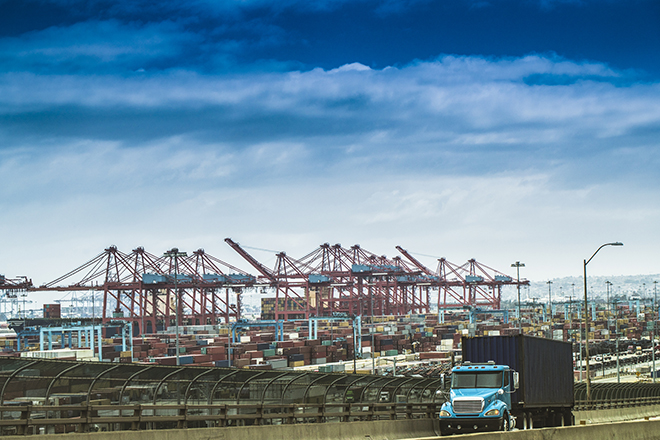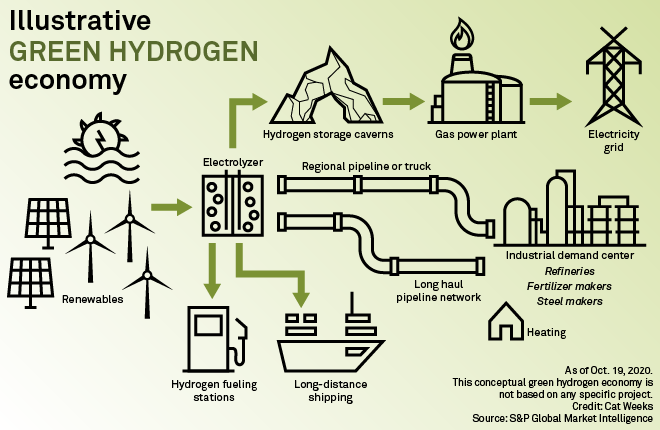S&P Global Offerings
Featured Topics
Featured Products
Events
S&P Global Offerings
Featured Topics
Featured Products
Events
S&P Global Offerings
Featured Topics
Featured Products
Events
Banking & Capital Markets
Economy & Finance
Energy Transition & Sustainability
Technology & Innovation
Podcasts & Newsletters
Banking & Capital Markets
Economy & Finance
Energy Transition & Sustainability
Technology & Innovation
Podcasts & Newsletters
S&P Global Offerings
Featured Topics
Featured Products
Events
3 Sep, 2021

|
A pure hydrogen pipeline and storage network could reduce the delivered cost of green hydrogen, enabling the low-carbon fuel's uptake in power generation, port operations, heavy-duty trucking and maritime shipping, according to the HyDeal LA partnership. Source: LPETTET/ E+ via Getty Images |
Both dedicated hydrogen lines and the existing natural gas pipeline grid will be critical to making a proposed Los Angeles green hydrogen hub viable, according to the Green Hydrogen Coalition, one of the project's chief developers.
The insight was one of several findings the Green Hydrogen Coalition, or GHC, shared from its phase 1 study of HyDeal LA, a project that aims to develop the nation's first green hydrogen hub and drive down the fuel's cost to $1.50 per kilogram by 2030. Hydrogen is considered "green" if the source of power used to produce it by splitting water through electrolysis is zero-carbon.
GHC presented its findings on Sept. 1 at the U.S. Department of Energy's Hydrogen Shot summit, which convened DOE staff and hydrogen stakeholders to further the agency's program to cut the cost of low-carbon hydrogen by 80% to $1/kg within a decade.
"Here's the good news: sub-$2/kg, mass-scale green hydrogen delivered to the L.A. Basin is feasible by 2030," GHC founder and President Janice Lin said. "Transport and storage infrastructure is a key driver."
Role of pipelines and storage
Using 100% hydrogen pipeline infrastructure and underground geological storage can make possible that low-cost hydrogen, the HyDeal LA study concluded. The partners believe developing a dedicated hydrogen system is feasible by 2030-2035, provided federal agencies clarify regulatory authority for interstate hydrogen pipelines, Lin said.
It is not currently clear which agency has authority to determine who can operate blended and pure interstate hydrogen pipelines and set transmission rates, according to the study. Because this ambiguity could impede project development, the federal government should confirm that the Federal Energy Regulatory Commission is the economic regulator for hydrogen pipelines, either through legislation or administrative action, the partnership recommended. FERC is the economic regulator and permitting agency for interstate natural gas pipelines.

Lin mapped out two storage scenarios: dedicated hydrogen pipelines would connect to salt dome storage in Utah at a delivered cost of $1.95/kg, or in Nevada at $1.60/kg. Out-of-state salt dome formations would provide mass-scale storage needed to balance green hydrogen supply and demand throughout the year, Lin said. Developing the Utah storage hub would require about $27 billion in capital expenditures throughout the value chain, including "significant" private sector investment, she added.
The hydrogen pipeline network would connect to offtaker hubs in L.A., as well as Victorville, Calif., a commercial center in the high desert, and Bakersfield, Calif., an agricultural and energy hub. Project partners did not model using road transport or rail for hydrogen transportation, Lin said.
In the near term, project partners recommended blending hydrogen into existing gas pipelines to help scale production. Southern California Gas Co. President Maryam Brown said regulators and regulated utilities should prioritize developing hydrogen injection and gas standards to support hydrogen blending. She said they should also use the utility regulatory framework to spur private-sector investment and spread infrastructure spending across the rate base. Utilities have experience developing infrastructure projects designed for reasonable returns governed by law, she noted.
Hydrogen production findings
On the supply side, substantial hydrogen production within the L.A. basin could be possible if producers are able to access low-cost renewable power through existing electric power infrastructure, the partners found. They recommended that regulators develop an electric tariff framework that allows producers to access grid-provided clean power for electrolysis. The tariff should enable dispatchable demand response and account for green hydrogen's environmental attributes in a way that avoids double counting green credits, they said. Drawing power directly from the grid for green hydrogen production could draw scrutiny, because California's transmission lines still carry electricity generated by fossil fuel-fired power plants.
Following the phase 1 study, Lin noted that GHC supports converting waste into hydrogen. The HyDeal LA partnership suggested collaborating with municipal agencies to develop a roadmap for in-basin waste-to-hydrogen production.
The partners further recommended establishing a national framework to track, verify, and compensate green hydrogen for its environmental benefits. The group also advised exploring green hydrogen production for fertilizers, maritime shipping and aviation fuels in coordination with federal agencies that oversee compliance requirements and international port and airport decarbonization programs.
Developing demand centers
Access to plentiful, predictable, and reasonably-priced hydrogen would prompt Fenix Marine Services Ltd. to transition most of its roughly 350 pieces of diesel-powered equipment at its 300-acre Port of Los Angeles marine terminal, said Scott Schoenfeld, the terminal's general manager. Low-cost supply would also open the door to converting the 5,000 trucks per day that visit the terminal, as well as a dozen other area terminals and eventually the ships and trains that service them, he said.
The anchor offtaker for HyDeal LA is the Los Angeles Department of Water and Power California, which plans to convert several gas-fired power plants previously scheduled for retirement over the coming decade.
Lin said the plan to scale near-term hydrogen demand at power plants and oil refineries justifies investment in transportation and storage infrastructure, which in turn will reduce delivered costs. That early-phase uptake can also help spur demand in sectors such as heavy duty trucking, accelerating the transition from diesel fuel and reducing pollution in historically overburdened communities.
However, the HyDeal LA plan is not without environmental and equity concerns. Green groups have lately issued warnings about hydrogen blending in gas turbines, citing the potential for increased nitrous oxide pollution to exacerbate health disparities in environmental justice communities. Combustion studies by General Electric Co. indicated that a 50-50 mixture of hydrogen and natural gas could increase the concentration of NOx in turbine exhaust by 35%, requiring larger and more efficient systems to reduce emissions.
